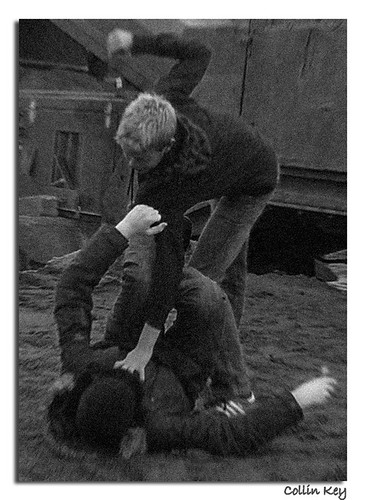Pacing back and forth on stage, which is my custom to the chagrin of my 8th grade speech and debate teacher, I press the button on my clicker and the slide on the large screen at the front of my 500 hundred seat theater changes. I pause my lecture momentarily and look out over a sea of faces, counting how many have furrowed brows or heads cocked sideways like a confused house pet. The slide is simple with a black background and white letters that shows a quote from our text book You May Ask Yourself[1]:

I stand quiet and the rare silence draws the eyes of the entire class toward the stage. I wait for a few moments and ask, “do you see it?” Awkward silence and muted chuckles fill the air until someone, typically in the front, raises their hand and asks, “do we see what?” “Oh, you don’t see it. Here, let me help you.” I push my clicker and this appears behind me:

“Do you see it now?” I ask again. After the confused silence becomes unbearable a student will inevitably say something to the effect of, “wow, that really sucks for women. Is that what you are looking for?” I shake my head no. “What would a conflict theorist say about this last half of the sentence.” Still nothing. “Ok, don’t feel bad, what I’m asking you to do is some fairly high-level analysis and that takes practice.”
“You’ll remember that conflict theorist are always asking, ‘who benefits from this?’” I hope you’ll also remember how conflict theory argues that those in power hide in plain sight either because their privilege seems unremarkable or because the privileged are not spoken about. With this in mind look at this sentence again and ask the conflict theorist’s question, ‘who benefits from this?’"
The class and I work together to solve the mystery of the loaded language and it doesn’t take long for us to decide that men benefit from sentences like this.
The inspiration for this activity came from what Michael Kimmel (2004) wrote in the New Internationalist magazine:
Often, though, the invisibility of masculinity makes it hard to see how gender equality will actually benefit us as men. For example, while we speak of the ‘feminization of poverty’ we rarely ‘see’ its other side – the ‘masculinization of wealth’. Instead of saying that US women, on average, earn 70 per cent of what US men earn, what happens if we say that men are earning $1.30 for every dollar women earn? Now suddenly privilege is visible!
I push the clicker one more time and the following appears:

With a single question we start a class long discussion about gender, privilege, and the social construction of reality. “Why don’t we say it like this?”
References:
Kimmel, Michael. 2004. “A Black Woman Took My Job.” The New Internationalist Retrieved online July 30, 2012. http://www.newint.org/features/2004/11/01/men/
-
This is in no way intended to be a critique of Conley’s You May Ask Yourself rather it is a critique of nearly all introduction to sociology books. I flipped through 5+ intro books before writing this and all of them have a sentence similar to the one that appears in my slide above. ↩







